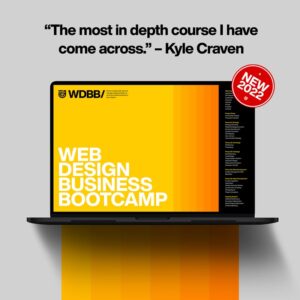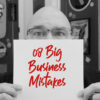Busy. Busy. Busy. You are so busy and you are not sure how to get out of it. I was there about a year into freelancing. I was so busy that I barely had time to breathe. My stress was at maximum. My time was at minimum.
My big problem was a massive lack of business knowledge and experience. I had no idea how to get myself out of the mess I was in. I needed more help. I needed employees, but I had no idea if I was ready to hire people. Did I have enough money? Who should I hire first? What if it doesn’t work out and I am stuck with increased overhead?
When enough finally became enough, I finally took the plunge and hired my first team member. A year later I had five employees and office space and about a year after that I finally understood some of the things I needed to understand to scale my business. I will share them with you now.

This is my agency team in 2012. I had custom bobbleheads made of each team member as part of their year end gift. I am so grateful that I got over my fear of hiring people and had an awesome team like this.
Can you financially afford to hire someone?
Fear of lack of money is what inhibits most entrepreneurs from hiring team members. Do you have enough money to keep your business running, pay yourself, and hire a new team member? Let’s look at a breakdown.
You should have three to six months of cash reserves in your business. This is the golden rule for small businesses. If your business has a monthly overhead of $8,000, you should have $24,000 to $48,000 of cash flow coverage available to support your business. This may seem like a daunting number for a lot of creative entrepreneurs. However, if you look at the numbers from a few angles, it can be very reasonable to attain.
Money in the Bank: This is the most obvious place where you have cash reserves. In this situation, let’s say you have $16,000 in the bank. (Two months of cash flow coverage.)
Money in Receivables: This is the money that you have invoiced to clients, but has not yet been paid. You finished some projects and invoices are coming due. Let’s say you have $8,000 in money you are waiting to collect. (One month of cash flow coverage.)
Money in Working Projects: This is money you will invoice in the future. This must be signed contracts and working projects (not “possible” projects or even “probable” projects). Don’t count it unless it is fully green lit and moving forward. (Don’t count your chickens before they hatch, as they say.) Let’s say you have a few working projects at a value of $24,000 that you will invoice over the next two to three months. (Three months of cash flow coverage.)
- Money in the Bank: $16,000
- Money in Receivables: $8,000
- Money in Working Projects: $24,000
- Total: $48,000 (six months of cash flow coverage at $8,000 per month)
Hey! Look at that! You have enough cash flow to cover six months of expenses for your business at $8,000 per month. Here is how you look at the finances when hiring someone.
Any amount over the three to six months of cash flow coverage is subject for reinvestment into your business. That’s the rule. In this case, you have six months of cash flow coverage. You might consider investing three months of that money into hiring an employee (which would still leave you with three months of cash flow coverage – in the healthy small business zone).

Save three to six months of cash flow coverage. Everything you have above that is available to reinvest into your business.
In this case, you could consider $24,000 of money you are willing to reinvest into your business in the form of hiring team members. (Spending $24,000 on employees will still leave you with $24,000 in cash flow coverage – or three months at $8,000 per month.)
- Sub Total: $48,000 (six months of cash flow coverage at $8,000 per month)
- Reinvestment Money: $24,000 (you can be willing to spend this on business expansion)
- Total Money Left: $24,000 (you still have three months of cash flow coverage)
What should I hire people to do?
You are drowning in work and overwhelmed by the stress of having so many balls in the air. Everywhere you look there is a need.
Make a list of EVERYTHING you do in your business and EVERYTHING that needs to be done, that isn’t getting done now. Don’t be afraid to get granular on these lists.

When I first did this exercise, I filled a piece of paper, single space, front and back with all the things I was currently doing and the stuff I knew needed to be done, but nobody was doing. My list included everything from sending invoices to updating my website with new project case studies…from following up with a sales lead to scoping projects. Include everything you can think of on your list and don’t be surprised if the list is long.
Next, examine the list for these things:
Stuff you can hire a junior level person to do: It doesn’t take a masters degree in business to email an invoice to a client or categorize transactions in your Quickbooks account. You can hire an administrative assistant to do things like that.
Stuff you don’t want to do: What are the tasks you dislike? Mark them as things you will hire someone else to do.
Stuff you don’t know how to do (and don’t want to learn): Over my career I developed a lot of skills: design, video editing, animation, front-end development etc. but I never became super excited about back-end development. I don’t know how to do it and I don’t want to learn. That is something I hire against. What are the things you don’t know how to do and don’t want to learn? Mark them on your list.
Stuff you aren’t good at (and don’t want to get good at): Not good at sales (and hate the idea of getting good at it)? Hire against it. Mark the things on your list that are not your strong suits and you don’t want to practice them to improve.
Now, look at your list. These are the things you should hire for.
Who should I hire first? I have so many needs.
The next step is to determine what type of people you need to hire to fulfill the “stuff” on your list. Do you want an art director? A production designer? An administrative assistant? A sales person? “All of them,” you say. Great! Then write a job description for all of them and post all of them.
Get some applicants to consider. Start interviewing for all the positions and hire the first person who seems like a good fit! If you find a great art director first, hire that person first. If you find an amazing sales person first, hire that person. When you have so many needs, you can’t control the order in which you hire. So interview for multiple positions and make your hiring decision (and order) based on the candidates you find.

How do I hire the right people?
Hiring people is an artform in itself. You have to ask the right questions, be a good judge of character, and take some calculated risks. Here is the things I looked for when hiring a new team member (these are mostly in order of importance to me):
Cultural Fit: Is the person a good fit for our business? Will the vibe with the team? Are they someone I would like to spend time with?
Integrity: Can I trust them with my trade secrets? Will I be worried about giving them a key to my office? Do they seem to have a solid moral compass?
Ambition to Learn: Are they eager to learn and grow? Are they willing to develop new skills and fill gaps in my business?
Adaptability: Can they shift gears without stress? Are they going to be ok working at a growing business that seems to have a steady stream of changes and challenges?
Ability to Do the Work Now: Will their skillset have an immediate impact on our business? Or will it take time for them to get up to speed?
Value: Is the financial compensation they are asking for less than the value of the work they will contribute? (e.g. If a candidate is asking for a six figure salary, but they can’t produce six figure work for your business, their value is low. In contrast, if a candidate is asking for a mid five figure salary but can produce six figure work, their value is high.)
What if it doesn’t work out?
Stop being so negative. What if it DOES work out! But just in case, here is the way to mitigate the risk of it possibly not working out.
Yep, it may not work out. Your new employee might be great in the first year and then be a disaster in the second year. Or maybe this person will be a ten year cornerstone for your business. You just don’t know. Hiring team members involves some risk. And the best way to navigate that risk (in your mind) is to cap the amount of risk you are willing to take. I recommend three months.
We started this conversation by looking at your finances. In our scenario you have six months of cash flow coverage. Great! Let’s risk some of that money in this “team member experiment.”
If you hired a new team member for a $60,000 per year salary it is equivalent to $5,000 per month. You have $24,000 of cash flow coverage available to reinvest into your business. Hire your new team member on a three month experiment with an investment risk of $15,000 ($5k per month for three months).
At the end of the three month experiment, you will either LOVE your new team member in a “can’t live without them” kind of way OR you will be ready to let them go and consider your $15,000 spend on their three month salary as a “bad investment.” Most of the time, it doesn’t take three months to know if the person is going to work out or not.
Your hiring success depends as much on your new team member as it does on you.
Still worried that it won’t work out? Well, that has much to do with your new team member’s ability to integrate themselves into your business as it does with your putting them on the right projects and tasks. It is not all on you!
You’re giving them an opportunity. Good team members will take that opportunity and prove themselves to you.
If you hire right, it will all work out. Your business will grow. You will be happier and less stressed. Your new team members will become your life long friends and you’ll make lots of money together!












